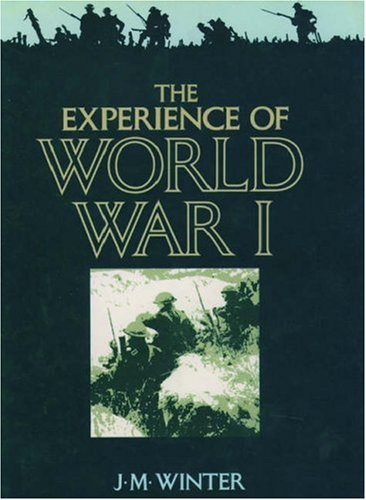The Experience of World War I
By J.M. WinterPublished by New York, Oxford University Press, 1989
The central theme of The Experience of World War I is the gigantic scale of the military effort waged by approximately 70 million men in uniform. Winter’s account answers such questions as “Why did the generals persist in large-scale offensives after the catastrophic losses early in the war?” and “What was the impact of the war on the world economy and European politics?” These are answered by describing the conflict, year by year, as it was experienced by generals, soldiers, politicians, and civilians. A number of secondary topics are also explored, including women’s war poetry, graphic arts, and films of the war. Winter draws on firsthand accounts of life during the war, including diaries and memoirs by both men and women from all countries and from all social groups.
The Experience of World War I is copiously illustrated with hundreds of color as well as black and white photographs. It includes color maps, a full chronology of the war and tables of essential data such as the names of wartime politicians and their periods of service.
By dividing World War 1 into four phases — 1914, the war of illusions; 1915, stalemate and stagnation; 1916–17, the great slaughter; and 1917–1918, revolution and peace — The Experience of World War 1 provides a clear structure to the exploration of the complexity of the events of 1914–1918, from the bloody battles of Verdun, the Somme, and Passchendaele to the flood of literary and artistic works during and after the war. While Winter acknowledges that the complexity of the war cannot be contained within any simple explanatory framework, The Experience of World War I achieves its primary aim to “highlight the salient features of a conflict which has moved from reality to myth.” Such little known details as the limited period of time, e.g. two weeks out of one month spent by soldiers in the trenches and the amount of food needed to feed five million men in the British army, provide fascinating reading.
The Experience of World War I is a worthy forerunner to J.M. Winter’s more recent works, such as Sites of Memory, Sites of Mourning: The Great War in European Cultural History (1995). le.
Jane Mattisson Ekstam
The Experience of World War I is copiously illustrated with hundreds of color as well as black and white photographs. It includes color maps, a full chronology of the war and tables of essential data such as the names of wartime politicians and their periods of service.
 |
The Experience of World War I is a worthy forerunner to J.M. Winter’s more recent works, such as Sites of Memory, Sites of Mourning: The Great War in European Cultural History (1995). le.

No comments:
Post a Comment